Marijn Lybaert isn’t the type of guy to take no for an answer. “Bill, say it!” He admonished me excitedly, his slightly accented English combining with his puffy cheeks to give off an air of cherubicness. I stared at him blankly. There was no way I could repeat whatever he had just said back to him. English tongues couldn’t make some of those sounds, I was certain of it.
“Marijn…” I hesitated.
“Bill, say it!”
*Sigh* “Ik ben een aap.”
What the hell does THAT mean?
“See Billy?” He said, laughing. “You’ll be speaking Dutch in no time!”
…
Please allow me to introduce myself…
Last week was my first article for StarCityGames.com in a number of years, and the beginning of a (hopefully) fruitful relationship after a rocky turn of events at a different site. What you read was the first part of a four week series that will see me literally travel around the globe as I cover two major events for Wizards of the Coast’s official event coverage team… Pro Tour: Kuala Lumpur and Grand Prix: Vancouver. Over the past year I’ve covered a number of events for Wizards and I’m always excited to be signed up for another one, though nothing makes me want to battle like watching the world’s best compete.
This week is all about Kuala Lumpur and my week in the country traveling with friends before the event. Because of time constraints and deadlines, my piece on the Pro Tour and intro to Vancouver won’t come until next week, so look for it then. In the meanwhile, let’s get started, shall we?
Traveling
I love traveling, I always have. When I was an undergrad intrepidly journeying out on my first few PTQ adventures with friends I relished getting up early to adventure to a new locale and a day’s worth of battling. Eight years later I still get tingly every time I board a plane for a Magic trip, though the locales have changed from “Chicago” and “Minneapolis” to “Valencia” and “Kuala Lumpur.” Malaysia. I never would have thought.
Still, even I have my limits and at the beginning of this trip I met them pretty quickly. I couldn’t sleep the night before I left and finally managed to grab perhaps two hours before getting up to leave for the airport. My first flight, from Cedar Rapids, Iowa to Chicago, was stranded on the tarmac for an extra hour due to weather in the Windy City. Once I got to Illinois I had a three hour layover before a fourteen and a half hour flight to China. Fourteen and a half hours is crazy. That’s over half a day on an airplane. The whole trip over I felt bad for the flight attendants. When was the last time you worked a 14.5 hour shift?
Things went pretty smoothly, however, and I’ve got to say, being in China was kind of weird in a neat way even though I was only there for four hours. While waiting for my connection to KL a group of small Chinese children became captivated with me, presumably because of how out of place I must have seemed. The only white guy at the gate sitting quietly reading with my un-gelled mohawk lazily splayed over the top of my head; they kept pointing at it and giggling. Eventually they devised a game that went something like: whisper with each other and point at me while giggling, cautiously approach the seat next to me and sit in it while pretending to be interested in something that wasn’t me, then rush back to the safety of home base in the seat next to their friends where they all collapsed into giggles. I kept reading quietly but couldn’t keep myself from smiling. Eventually I took a piece of notebook paper out and started folding it into a paper airplane. The kids were pretty captivated but eventually Mama, likely concerned about stranger danger, collected them to her before I could send the ship on its first voyage in their direction.
By the final flight of the “day” I was ready to be done with traveling. The thought of lying flat on a bed at my hotel in Kuala Lumpur was positively exhilarating, and it was all I could do to keep my head up while the food carts went up and down the aisle of the airplane. Eventually we “got there” and I collapsed exhausted into my hotel bed, which was as refreshing as I had anticipated.
Meet the Players
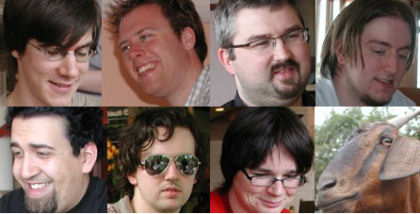
(l-r) Jan Doise, Stijn Van Goethem, Tom de Wael, Christoph Greigor, Stan Van Der Velden, Fried Meulders, Marijn Lyabert, Bill Stark
It all started with Tim Galbiati. At Pro Tour: Prague in 2005, Tim introduced me to a friend of his, StarCityGames.com own Zac Hill. We quickly bonded, and for Valencia in 2006 Zac said he had a lead on rooming with some friends of his from Belgium. They had a spot and wanted to know if I was up for hanging out prior to the PT; it sounded good to me. His friends happened to include Marijn Lybaert and Fried (freed) Meulders. We had a lot of fun, and for this event Marijn asked if I wanted to join a group of Belgian players at a beachside resort the week prior to the main event. Apparently they only had seven and needed one more for a draft pod; I was all too happy to acquiesce.
Coming into the event I had worked with Marijn Lybaert, Jan Doise, Stan Van Der Velden, and Fried Meulders in some capacity or another, and felt familiar with all of them. I didn’t know Christophe Gregoir, Tom de Wael, or Stijn Van Goethem, but the group seemed close knit considering the proximity to one another at home in Belgium.
Fried, Jan, and I were the first to arrive in Port Dickson, site of our resort and the first half of our stay. The view from the lobby:
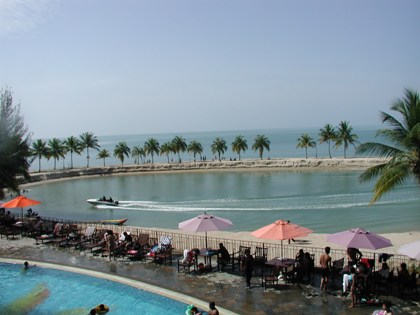
In the cab from Kuala Lumpur to Port Dickson our driver regaled us with stories about Malaysia and Kuala Lumpur while Jan and I asked him questions. After an hour the driver turned to Fried and said “Do you talk?” Fried, obviously caught off guard simply smiled and credited jetlag with keeping him silent. The reality is that it’s the type of person and player he is. Currently the Belgian national champion, he is often credited as being one of the up-and-coming stars from Belgium, and for good reason. His presence and demeanor are unassuming, but to draw the wrong conclusions from his silence will only end with you signing the match slip in his favor. Even our cabby recognized that:
“It’s the quiet ones you have to watch out for!”
Jan, on the other hand, is a bit more talkative and speaks three languages (Dutch, French, and English). I’m always amazed at people who can pull that off, but he pointed out that his father was an English teacher and that in Europe you have to speak five or so languages fluently before people are impressed. Throughout the week he offered up the most advice on drafting, and while I think each of us learned from the other in our group of eight, I felt Jan had a special knack for enlightening those around him. Must be genetic.
Marijn, the happy-go-luckiest Belgian of them all, was to be my roommate for the weekend, and he eventually made it in to Port Dickson after Jan, Fried, and I had arrived. Marijn (loosely pronounced “Muh-rain”) is a bit of an enigma, seemingly with connections amongst every group of pros in the world except for most of the Americans, though Cedric Phillips has been known to refer to him as “Martin the Bear.” The most fascinating part of his personality is the way in which he interacts with the Japanese players. Following a line of Europeans who can’t speak Japanese but have befriended members of that community, Marijn regularly cajoles Tomohiro Saito and particularly Kazuya Mitamura, whom he refers to as “The Chief” for his uncanny resemblance in person and mannerism to the so-named character in Jack Nicholson’s “One Flew Over the Cuckoo’s Nest.”
One of Marijn’s goals in life is to get his smiling mug on a player card, which would earn Tom de Wael, the resident “old man” of the group (edging me out by not enough years I fear) an Eric Taylor-like fate. For some reason Tom swore that if Marijn ever got said card he would eat one in protest. Good-natured jesting aside, Tom was one of the two Belgians who weren’t of a significant level in the PT club, though he had played a few Pro Tours over the years. During the day at home he worked as a social worker, and when I asked him how such a job compares to the type of social worker position most Americans are accustomed to, he explained his specific responsibilities were considerably different. His job as a social worker was not monitoring Belgians but instead working with refugees from countries like Rwanda and Somalia to find them a place to live and a walk of life in the country. When I told him that was a pretty noble calling, he shrugged and said “It’s a job” in that typical European nonchalant fashion.
Stijn Van Goethem was the other player who was not attending the PT thanks to his status in the player’s club. Instead Stijn was playing his first Pro Tour after winning a slot. The easygoing Belgian spent much of the weekend joking around with me and seemed, like anyone playing their first major event, to be nervously excited. That can wear off quick in the hard knock world of a Limited Pro Tour, where anything less than 2-1, 2-1 over your first two pods leaves you watching for the rest of the weekend, but his attitude was right for his first event.
Christophe Gregoir is another member of the rising Belgians club, and judging by the amount of our practice drafts he won he was in good position to do well this weekend. A computer science student at home, Kuala Lumpur marked the last event for him before he began a new job as a software engineer. As an interesting side-note, his passport photo when turned upside down looks exactly like Jelger Wiegersma.
Finally we have Dutch transplant Stan Van Der Velden. A former poker pro who gave up the life despite being successful at it because he didn’t enjoy it, Stan has been away from Magic until this year when he accidentally Top 8ed his Nationals tournament. When a member of the Top 8 couldn’t make the trip to New York, he took the spot, and after a strong performance at the PT in addition to winning a PTQ for Kuala Lumpur, he found himself back on tour. Stan is the type of guy you’re imagining when you think of euro cool… calmly laid back with dyed hair spiked up, smoking a cigarette carefully in between each draft, and working as a bartender when he’s not traveling the globe playing Magic.
Drafting
My goal for the week was to draft as often as possible, aiming for five a day. The Belgians, who would actually be playing the Pro Tour instead of simply writing about it, were more keen on swimming, eating, relaxing, and enjoying Port Dickson (the town where our resort was located). Still, we got four drafts in on our first full day in the city.
It’s difficult to deduce the full impact of Morningtide on the Lorwyn draft format. Last week I wrote about a few of the changes to the tribes that felt important to mention, and they were correct for the most part (Jan disagreed with me slightly on Faeries/Rogues, saying “It didn’t go up, but it didn’t go down either”). Still, what do you draft?
Christophe Gregoir managed to win our first pod with a Mono-Green Elves deck. Jan won a few in a row and it seemed like no one could beat him, but he eventually gave up his spot at the top of the heap to Marijn, and I scored a match off of him with a UW control list I put together featuring Austere Command and a tabled Arbiter of Knollridge who, incidentally, is a Wizard reduced in cost by Stonybrook Banneret. For the most part no one was sitting down at the table with a specific archetype in mind, and for good reason. I had tried to force Faeries/Rogues during one of the early pods after noticing many of the cards for it had been under-drafted in our previous pod. I even went so far as taking Dreamspoiler Witches over Epic Proportions in my pack 1,pick 1 spot, sacrificing the power of Epic Proportions for the hopes of taking advantage of prowl goodies in pack 3.
Naturally that didn’t pan out as I saw a grand total of one prowl card (Stinkdrinker Bandit) in the final pack, and I got wrecked. The player who won the pod? Jan Doise, who nabbed that Epic Proportions third (Tom de Wael passed it as well). Later that afternoon while lounging by the pool we discussed that particular pick, and he explained his take on the format: normally he sat down to draft the best cards as they came in order to determine where his neighbors were headed. After the first pack he’d have a goal in mind, and then tried to follow through on the final two packs keeping tribes and classes in mind, but not necessarily focusing on them to exclusivity. That seemed like a reasonable if traditional plan of action, and I vowed to stick closer to it throughout the course of the weekend. While forcing can pay benefits, and a single data set does not a statistically significant sample size make, it does behoove you to learn the basics of the format before getting fancy with forcing.
Of course, playing Magic in public next to the hotel restaurant at your super resort paradise of awesomeness does bring curious onlookers, and our pods didn’t disappoint with tourists from all walks of life poking their heads in to our table to see what was going on with all those cards. Most of the onlookers were middle-aged-or-older adults, probably wondering how a group of college-age looking Europeans/American could afford to spend all day “on vacation” playing games. At one point, however, a younger duo stopped by clearly drawn in to what we were doing and well within the range of “target audience” for Magic. The two boys, aged probably 8 and 14, just didn’t leave watching me battle Stijn for close to twenty minutes. When it became clear they were really interested in what we were doing, I pulled my box of drafted cards from my bag and handed them a stack of cards to look through. The younger of the pair quickly dove in, sorting through them and excitedly looking at each card, while his brother, eyes wide in surprise at the gesture, offered up an excited “thank you.”
After another ten minutes they were still watching us play, no small feat considering they didn’t understand what was going on. Impressed with their interest, I reached back into my box and pulled out a stack of lands, handed it to the older brother, and asked where the two were from. Through some broken English they revealed they were on vacation from Taiwan, so I wrote down the url for the Magic tutorial site and told them to keep the cards and learn how to play. The younger of the two, who was busy dancing around looking at his collection of uncommons and commons, didn’t seem to notice our table existed anymore. He was lost to god knows what imaginations of dragons and dungeons and damsels in distress. The older brother offered up a gush of thank you’s, but I waved him off with a nod and smile while Marijn laughed at me in the background.
After they left Marijn, said “Bill, you’re crazy man! You gave them rares. RARES!” With my tongue firmly in my cheek I teased my Belgian friend back, saying “You can’t get to the Invitational without giving away some cards. M!” I figure it’s better to give up a Stonehewer Giant and Knucklebone Witch if it means adding a player or two to the community at large, right?
Wizards and Kuala Lumpur
Last week in the forums a number of respondents voiced intense dissatisfaction with the fact Wizards of the Coast selected Kuala Lumpur and Malaysia as the site of this year’s inaugural Pro Tour. I think Aaron Forsythe summed up an answer to those concerns best a few years back on the Mothership when discussing how Wizards had allowed Skullclamp to come into existence. The exact quote escapes me, but it went something along the lines of “The game is better off when WotC is challenging itself by stretching boundaries.” Sure, mistakes will be made, but that’s how the game is grown instead of stagnating.
So, is Kuala Lumpur right for the game? After a week in-country, I think so. It offers a flavor unlike any I think the Pro Tour has seen, in part because of what Malaysia represents as a country. An amalgam of Asian peoples, it reminds one of the United States actually, albeit swapping European peoples like the Irish, Italians, Germans, and Brits for Indians, Chinese, ethnic Malaysians, and a large contingent of Muslims (granted, not a nationality, but compare it to the U.S.’s Christian community). As I’m typing this, the Muslim call to prayer is being sounded outside my window; yet another experience unique to this event.
Are there problems with selecting Kuala Lumpur over a more traditional Asian selection like, say, a major city in Japan? Of course. For one thing, there is no Pro Tour in Japan this year, which is unfortunate. Customs in Malaysia are different than in the U.S. (travel guides I researched before leaving the country claimed things as odd as not eating with your left hand, not touching anyone on the head, and, unfortunately, not drinking the water from the tap without boiling it first), but not so different as to make travel impassable, or even all that uncomfortable. Indeed, many of the Europeans I talked to simply can’t wrap their heads around many oddities in the U.S. like our healthcare system (Jan Doise: “For Pro Tour: San Diego I opted not to buy insurance for visiting the country. Then on the plane I watched ‘Sicko’ and thought ‘nice play, Jan.'”), tipping, and prices without tax included (“So you pay a price, but when you actually pay the price they’re a different price!”).
Plus there are positives for Kuala Lumpur that you don’t have in Japan and other countries. For one, it’s a former colony of Great Britain, meaning it’s as English-friendly as a country can be. Everyone speaks some English, and most of the signs, restaurants, and assorted things you need to read come in English. On the way through the palm oil fields from Port Dixon, site of the first portion of our stay, our cabby turned on the radio. The music was awful, but it was awful American music with Jessica Simpson, that guy who’s doing a duet with Santana, etc. And of course now a champion with a major title has had the privilege of having a Pro Tour in his home country (Invitationalist winner Terry Soh).
Malaysia and Kuala Lumpur are interesting sites for the Pro Tour, and I’d rather see Wizards search for new and exotic locales to stretch the boundaries of the Pro Tour than simply let it stagnate bouncing back and forth between the same few places each year. Does that eventually lead to some challenges for the community? Yes (I’m writing this as I’m recovering from a bout of food poisoning), but every place in the world will inevitably lead to some problems so it’s not fair to bash on Kuala Lumpur when it really is no less attractive than most other sites.
Speaking Dutch
Belgium is a weird country in that, despite being smaller than some states in the U.S., is filled with three distinct languages and citizens who ardently support whichever one they speak. French, Dutch, and German are all spoken somewhere in the country, and not speaking one when you speak the other can lead to awkward faux pas (take, for example, Miss Belgium 2008, who was embarrassed to reveal she didn’t speak Dutch at all after a question during the beauty competition). In any case, all seven players in our tale spoke Dutch as their mother tongue, and I had made a token effort to learn it before leaving for Malaysia. I found a recording of the Dutch alphabet and listened to it on repeat for most of the trip across the pond, but the reality is that Dutch and English are two very different languages.
I quickly came up with a rule of thumb, however, for determining whether you’re saying a Dutch word, particularly names, wrong. It goes something like this:
1. If you speak English and…
2. You’re saying a Dutch word…
3. Then you’re saying it completely, totally, hopelessly incorrectly.
Throughout the weekend I pronounced most of the Belgian’s names differently. Stijn was, in phonetic English, “stain” or “stein,” Stan was “Stan” as we imagine it or “Stawn” (rhymes with yawn), Jan was normally “yawn” but once “joln,” and Marijn was muh-reen, muh-rhine, muh-rain, and at one point at the urging of the other Belgians just “Martin.” They easily laughed off my thick-tongued efforts to pronounce their names correctly and I did my best to try with their language, but most attempts to translate ended with a Dutch speaker repeating a word over and over while I repeated the sounds my English-trained ears recognized and failed to pick up on the sounds Dutch ears, or in this case Belgian, can hear.
Oh well. I did learn a “joke” from Fried, whose silent nature made it all the funnier because no one was expecting him to be the person telling jokes. It went something like this:
“Shark” in Dutch is pronounced “haai,” like the English “hi” or “high.” Two sharks are swimming together in the ocean. One turns to the other and says “Hi!” and the other one says “Oh my god! Where???”
The Pro Tour
I’m writing from my hotel in downtown Kuala Lumpur, and we’re just a few days away from the Pro Tour beginning (though by the time you’re reading this it will be underway). The past week has been a blast, even though I got ill for the final day, and I’ve really enjoyed my time traveling with the Belgians. It’s crazy to think that a silly game can provide you the opportunity to meet people from places like Belgium, befriend them, and travel with them in such exotic locales as Kuala Lumpur. What a life.
You can check out more coverage updates at the Mothership, and tune back here next week for a Pro Tour recap and preview of Vancouver.
…
Marijn: “Ach, so many cards to sort. Kelly will have a lot to do!”
*Pauses*
Marijn: “Bill, does your girlfriend sort your cards for you?”
Bill: *Incredulous laughter*
Marijn: “Ah, see! I TOLD you I got a good one!”
…
“Ik ben een aap.” I tried. Fried stared at me. Maybe he hadn’t heard.
“Ik ben een aap.” Again, confusion. Uh…
Marijn giggled mercilessly in the background. Something, I was beginning to expect, was amiss. “Fried, what did I just say?”
“Um, ‘I am a donkey’ in Dutch.”
“Thanks Fried.” Curse you, Martin the Bear…

Life is so hard…
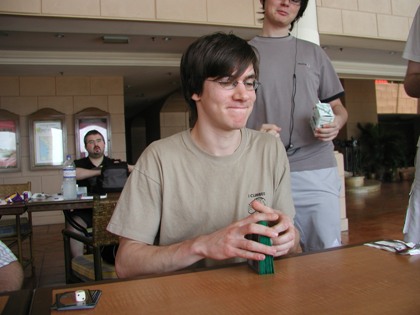
Jan preparing to bash for millions
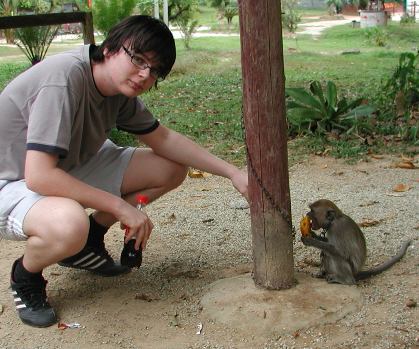
One of these is a macaque. The other is a Marijn. You figure out which is which…
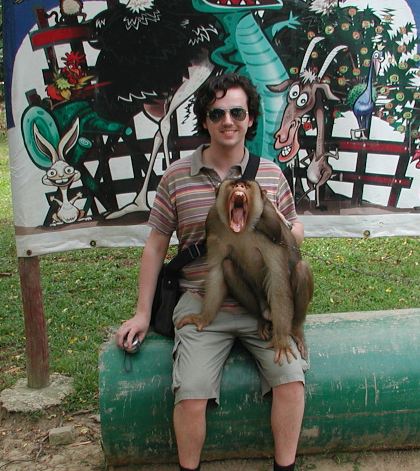
Even with simian cousins, Fried is still the quiet one.
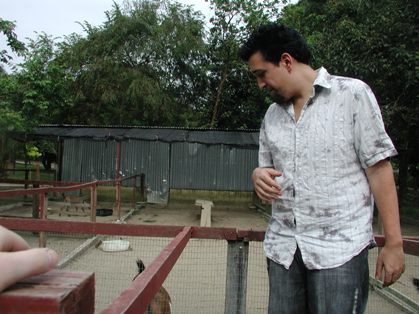
Stan tentatively scoping out some goats at a local zoo.

